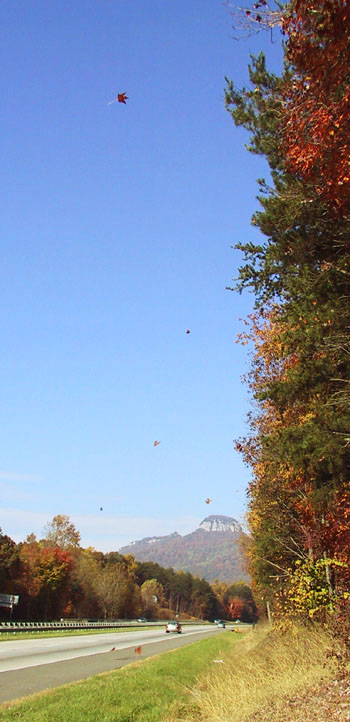 [Since I’m out of town, this post was scheduled ahead of time to appear today.]
[Since I’m out of town, this post was scheduled ahead of time to appear today.]
The image at right is an example of a planned shot, kind of. For years, I’ve had the idea of catching a falling autumn leaf in a gap of clear blue sky, surrounded by branches of fall colors – the idea is that the leaf would be close and dominating the frame, but clearly in free-fall. On the face of it, this may not seem so hard: simply pick a photogenic spot and wait for the wind to shake loose a prime subject. But from numerous attempts now, I can tell you there’s a lot more to it than that. Leaves fall surprisingly quickly and very erratically, dodging sideways in almost random directions. The requirements of maintaining tight focus and timing one within an ideal gap are demanding and, so far at least, beyond my abilities.
This is one of the more distinctive ways that nature photography differs from many other forms, like commercial, portrait, and artistic. While we may certainly plan a particular style of image, all too often it relies on vagaries of weather, light, animal behavior, and other such factors that we have little control over. It’s reasonable, and in fact recommended, to plan out some shooting opportunities, such as arriving in a photogenic locale before sunrise to be ready for the early morning colors, but it must be recognized that this is usually hit-or-miss; the sky colors may not be cooperating, or the sun may be blocked by distant clouds or cloaking fog and haze. The wind may be too stiff to capture the subjects we’re after, or a drought might have drastically changed the appearance of the foliage. Some things we have control over, and some we don’t, and must work around. This is naturally part of the challenge.
Thus it’s important not to sell oneself on the prospects of a good day of shooting, or of achieving the one special image we had in mind – that can lead very often to frustration, which can ruin our spirit for shooting. There is always another day. Meanwhile, other opportunities and ideas may be available when our sights aren’t set too narrowly, and this is one of the reasons I carry more than just one lens, everywhere I go. Even if you’re planning on nothing but landscapes, the rare insect might save your day, or some cooperative deer or raccoons might put on a show. Carrying a bunch of equipment can be tiring, but you’ll get over that with a good night’s sleep – the same can’t be said for missing the mating display of an egret because you left that lens behind; it “wasn’t in the plans.” Luck plays a large part in nature photography, but at the same time, so does being able to exploit it. Remain flexible and ready.
Yes, that background mountain you might have seen before – this was the same day, just a few klicks up the road. Or you may simply know it from visiting it yourself, since Pilot Mountain is a fairly well known natural attraction in the Piedmont region of North Carolina.




















































